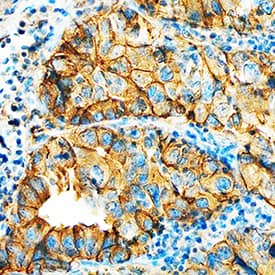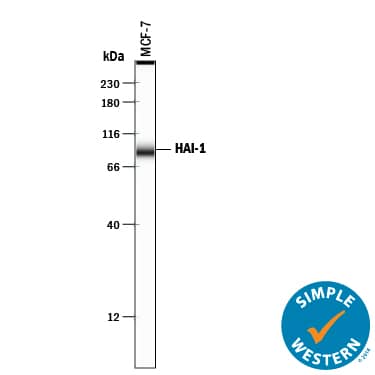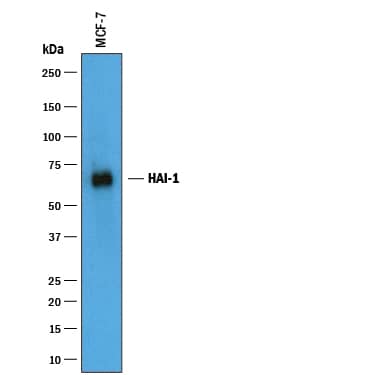Human HAI-1 Antibody
R&D Systems, part of Bio-Techne | Catalog # AF1048

Key Product Details
Species Reactivity
Validated:
Cited:
Applications
Validated:
Cited:
Label
Antibody Source
Product Specifications
Immunogen
Pro37-Glu449
Accession # NP_003701
Specificity
Clonality
Host
Isotype
Scientific Data Images for Human HAI-1 Antibody
Detection of Human HAI‑1 by Western Blot.
Western blot shows lysates of MCF-7 human breast cancer cell line. PVDF membrane was probed with 1 µg/mL of Goat Anti-Human HAI-1 Antigen Affinity-purified Polyclonal Antibody (Catalog # AF1048) followed by HRP-conjugated Anti-Goat IgG Secondary Antibody (Catalog # HAF019). A specific band was detected for HAI-1 at approximately 70 kDa (as indicated). This experiment was conducted under reducing conditions and using Immunoblot Buffer Group 1.HAI‑1 in Human Lung Cancer Tissue.
HAI-1 was detected in immersion fixed paraffin-embedded sections of human lung cancer tissue using Goat Anti-Human HAI-1 Antigen Affinity-purified Polyclonal Antibody (Catalog # AF1048) at 5 µg/mL overnight at 4 °C. Tissue was stained using the Anti-Goat HRP-DAB Cell & Tissue Staining Kit (brown; Catalog # CTS008) and counterstained with hematoxylin (blue). Specific staining was localized to plasma membrane in epithelial cells. View our protocol for Chromogenic IHC Staining of Paraffin-embedded Tissue Sections.Detection of Human HAI‑1 by Simple WesternTM.
Simple Western lane view shows lysates of MCF-7 human breast cancer cell line, loaded at 0.2 mg/mL. A specific band was detected for HAI-1 at approximately 88 kDa (as indicated) using 10 µg/mL of Goat Anti-Human HAI-1 Antigen Affinity-purified Polyclonal Antibody (Catalog # AF1048) followed by 1:50 dilution of HRP-conjugated Anti-Goat IgG Secondary Antibody (Catalog # HAF109). This experiment was conducted under reducing conditions and using the 12-230 kDa separation system. Non-specific interaction with the 230 kDa Simple Western standard may be seen with this antibody.Applications for Human HAI-1 Antibody
Immunohistochemistry
Sample: Immersion fixed paraffin-embedded sections of human lung cancer tissue
Simple Western
Sample: MCF‑7 human breast cancer cell line
Western Blot
Sample: MCF‑7 human breast cancer cell line
Formulation, Preparation, and Storage
Purification
Reconstitution
Formulation
Shipping
Stability & Storage
- 12 months from date of receipt, -20 to -70 °C as supplied.
- 1 month, 2 to 8 °C under sterile conditions after reconstitution.
- 6 months, -20 to -70 °C under sterile conditions after reconstitution.
Background: HAI-1
HAI-1 is a Kunitz-type serine protease inhibitor, identified as a strong inhibitor of HGF activator (HGFA) and matriptase (1). The membrane-anchored HAI-1 consists of two Kunitz domains, a LDL-receptor-like domain, and a C-terminal transmembrane domain (2). Two soluble forms are generated by ectodomain shedding, one with a single Kunitz domain and the other with two Kunitz domains. HAI-1 is not only an inhibitor but also a specific receptor of active HGFA, acting as a reservoir of this enzyme on the cell surface (3). The shedding of HAI-1 and HGFA/HAI-1 complex is enhanced by treatment with phorbol 12-myristate 13-acetate or IL-1 beta. The regulated shedding is completely inhibited by a synthetic zinc metalloprotease inhibitor (3).
References
- Denda, K. et al. (2002) J. Biol. Chem. 277:14053.
- Shimomura, T. et al. (1997) J. Biol. Chem. 272:6370.
- Kataoka, H. et al. (2000) J. Biol. Chem. 275:40453.
Long Name
Alternate Names
Gene Symbol
UniProt
Additional HAI-1 Products
Product Documents for Human HAI-1 Antibody
Product Specific Notices for Human HAI-1 Antibody
For research use only


